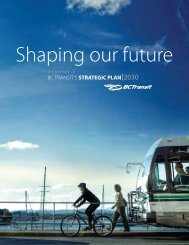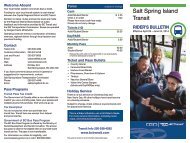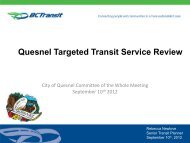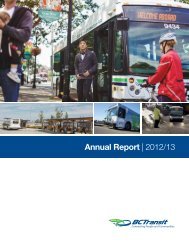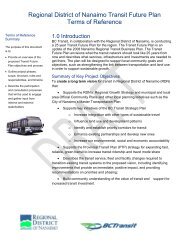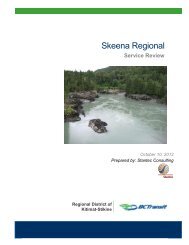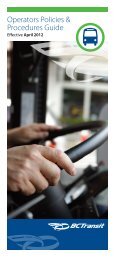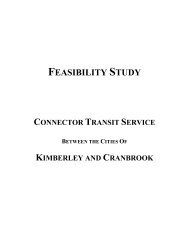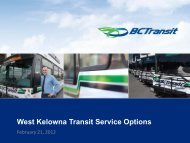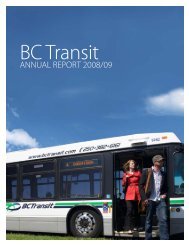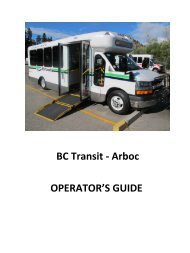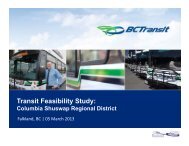TR-012 Trident Decker Bus Manual - BC Transit
TR-012 Trident Decker Bus Manual - BC Transit
TR-012 Trident Decker Bus Manual - BC Transit
- No tags were found...
Create successful ePaper yourself
Turn your PDF publications into a flip-book with our unique Google optimized e-Paper software.
SUPPLEMENT COOLANT ADDITIVESUPPLEMENT COOLANT ADDITIVEThe coolant additive should be used with heavy duty coolant, having aconcentration of 50% water mixture.Supplemental coolant additive (DCA4) concentration levels are dependentupon the presence of antifreeze to provide greater protection againstcorrosion, scale, and foaming. Antifreeze alone has insufficient additives forlong term protection.DCA4 coolant additive is available as a liquid or as a slow release coolantfilter. If DCA4 liquid is used DO NOT use a coolant filter that uses coolantadditives. The combination of liquid and filter coolant additives will resultin over concentration.Operators HandbookPublication No: 2138RECOMMENDED CONCEN<strong>TR</strong>ATION - DCA4CONCEN<strong>TR</strong>ATION DCA4 COOLANTMinimum - 0.33 units per litre 1 unit per 3 litresMaximum - 0.8 units per litre 2.4 units per 3 litresEXAMPLEVehicle system capacity 35 litres. 35 ÷ 3 litres = 11.6 units (minimum)Select nearest filter size 12 units (See parts manual).(Multiply by 2.4 to obtain maximum concentration - 27.8 units)Check the coolant additive concentration regularly with the DCA4 Coolanttest kit (Fleetguard Pt. No. CC2602M). The concentration should bebetween 0.3 units per litre (Minimum) and a 0.8 units per litre (Maximum).Note: The cooling system capacity quoted in the handbook and servicemanual is for the chassis only and does not include any allowance for thebodybuilders heater pipework.January 2000DRIVING AHEAD BY DESIGN32
IN<strong>TR</strong>ODUCTIONREFUELLINGThe purpose of this handbook is to provide information to assist the driverin operating the vehicle safely and efficiently.Care and attention given at the right time will ensure efficient andsatisfactory performance. Periodic attention is necessary, and should helpto avoid breakdowns. Never run the vehicle in a doubtful condition - alwaysreport back to the garage for inspection and attention.The Posilock refuelling system provides fast and efficient refuelling andeliminates waste and spillage. The nozzle simply twist locks onto theconnection and gives a firm sealed connection. The system allows aquicker turn round time, cleaner vehicles and depots and safer workingconditions.REFUELLING PROCEDUREDennis reserve the right to change the procedures, materials, specification,dimensions or design of the vehicle shown, described or referred to hereinat any time and without prior notice in accordance with the Company'spolicy of constant product improvement.NOTE: It is recommended that this handbook is kept with thevehicle. This handbook is based on the chassis and originalequipment fitted at the factory. You should therefore bear in mindthat the bodybuilder may have made changes to the vehicle. Forthis reason, you may find illustrations and / or certain parts of thetext in this handbook which do not correspond exactly to theparticular situation on your own vehicle.Remove dust cap Rotate the poppet Connect the nozzlefrom the filler neck. lever clockwise until to the adaptor andit locks in position. rotate it anti clockwiseto lock it in place.In all communications quote the relevant V.I.N., WPO and engine number.This will ensure prompt attention.DENNISDennis WayGuildfordSurrey GU1 1AFEnglandTelephone: +44 (0)1483 571271Facsimile: +44 (0)1483 301697Pull fuelling trigger Rotate the poppet Disengage nozzletowards you and notch lever clockwise. from adaptor with anlever open. The fuellinganticlockwise rotationtrigger will return to theand return the nozzleclosed position whento its holster.fuelling is complete.231
TYRE PRESSURESCONTENTSTYRE PRESSURE RECOMMENDATIONS - TYPICAL AXLE LOADSTYRE SIZE: BRIDGESTONE R192 305/70 R22.5 max. plated weightsLADEN FRONT AXLE LADEN DRIVE AXLE LADEN AUX. AXLELOAD LOAD LOADLoad Pressure Load Pressure Load Pressure(kg) (kg) (kg)psi bar psi bar psi bar7100 131 9.0 9500 91 6.25 6500 117 8.1Note: Unidirectional tyres require attention to rotation direction at fitment.The pressures quoted have been determined to ensure an acceptablecompromise between ride comfort, handling, and tyre life. Reduction ofpressures below those identified for any given axle load is not permittedunless agreed by the tyre manufacturer.An increase of up to 10% in front tyre pressures may provide improved fronttyre life, particularly in urban conditions where sharp corners or roundaboutsare frequently encountered. However, this improved life may beaccompanied by a reduction in ride quality.Increasing the rear tyre pressures in isolation is not permitted on rearengined bus applications, as handling could be adversely affected.In case of doubt, reference should be made to Dennis EngineeringDepartment or the Technical Department of the tyre manufacturer.PageIntroduction . . . . . . . . . . . . . . . . . . . . . . . . . . . . . . . . . . . 2Contents . . . . . . . . . . . . . . . . . . . . . . . . . . . . . . . . . . . . . 3Product Warnings . . . . . . . . . . . . . . . . . . . . . . . . . . . . . . 4General Description . . . . . . . . . . . . . . . . . . . . . . . . . . . . . 5Vehicle Identification . . . . . . . . . . . . . . . . . . . . . . . . . . . . 6Vehicle Identification Sheet . . . . . . . . . . . . . . . . . . . . . . . 7Daily Maintenance Checks . . . . . . . . . . . . . . . . . . . . . . . 8 - 9Engine compartment layout . . . . . . . . . . . . . . . . . . . . . . . 10Lubricants and Fluids . . . . . . . . . . . . . . . . . . . . . . . . . . . 11Warning Light Panel . . . . . . . . . . . . . . . . . . . . . . . . . . . . 12 - 14Controls and Instruments . . . . . . . . . . . . . . . . . . . . . . . . . 15 - 18Suspension System . . . . . . . . . . . . . . . . . . . . . . . . . . . . . 19Starting and DrivingEngine . . . . . . . . . . . . . . . . . . . . . . . . . . . . . . . . . . . . . . . 20Automatic Gearbox . . . . . . . . . . . . . . . . . . . . . . . . . . . . . 21 - 22Driving Downhill . . . . . . . . . . . . . . . . . . . . . . . . . . . . . . . . 23Retarder Operation . . . . . . . . . . . . . . . . . . . . . . . . . . . . . 23Stopping in Traffic & Parking . . . . . . . . . . . . . . . . . . . . . . 24Engine Shutdown & Engine Stop Control . . . . . . . . . . . . . 25Towing . . . . . . . . . . . . . . . . . . . . . . . . . . . . . . . . . . . . . . . 26Battery carrier . . . . . . . . . . . . . . . . . . . . . . . . . . . . . . . . . 27Jacking points . . . . . . . . . . . . . . . . . . . . . . . . . . . . . . . . . 28Emergency Repairs . . . . . . . . . . . . . . . . . . . . . . . . . . . . . 29Tyre Pressures . . . . . . . . . . . . . . . . . . . . . . . . . . . . . . . . 30Refuelling . . . . . . . . . . . . . . . . . . . . . . . . . . . . . . . . . . . . 31Coolant additive . . . . . . . . . . . . . . . . . . . . . . . . . . . . . . . . 3230 3
PRODUCT WARNING SIGNSEMERGENCY REPAIRSPlease take note of the following symbols, used throughout this manualwhich identify any health hazards or instructions to prevent any damage tothe vehicle.DANGER:CAUTION:This sign denotes an extreme, constant hazard.This sign denotes a reminder of safe practice.CHANGING ROAD WHEELS• Chock the wheels.• Using the jacking points, raise the wheel to be changed.• Check exposed wheel stud thread for damage. Remove the wheelnuts.• Remove the wheel.• Clean the mating edges of the hub and the wheel. Apply a thin coat ofwater repellent grease to the bore of the wheel.• Check the the threads of the wheel studs are undamaged, clean andfree from lubricant.• The only lubricant permitted is light engine oil on the thread of the nutonly.• Fit the wheel, refit the wheel nuts and gradually tighten in the correctsequence.WARNING:This is a prohibition sign. It is used to denote ahazard and indicates a practice not to be followed.Wheel NutTightening SequenceWheel nutTightening torque644 - 711 Nm (475 - 525 lb ft)• Wheel nuts should be re-torqued after the first loaded run.Note: When fitting twin rear wheels, ensure that the tyre valves arepositioned 180 o apart.Replacement TyresReplacement tyres should be of a similar specification. Fitting tyres of adifferent size or rating may affect accuracy of speedometer readings, andplated weight ratings. Do not mix crossply and radial tyres.4 29
JACKING POINTSGENERAL DESCRIPTIONThe <strong>Trident</strong> bus chassis is equipped with jacking points on all three axles.The jacking points should always be used when carrying out vehiclemaintenance. The diagram below shows their location.Front axle location:Jack up under axle beam directly below chassis frame.Drive axle location:Jack up under rearmost suspension mounting plate.Auxiliary location:Jack up under axle spring clamp plate.The Dennis <strong>Trident</strong> is a three axle bus chassis, powered by an electronicallycontrolled 6 cylinder turbo charged diesel engine driving a portal rear axlethrough an electronically controlled three or five speed automatictransmission.The air operated braking system is powered by an engine-drivencompressor supplying five reservoirs through an air dryer which alsoregulates pressure. Service One and Service Two reservoirs each supply aseparate system for the brakes on the front, drive, and Auxiliary axles. Thepark reservoir supplies the spring-applied, air released brakes on the driveand Auxiliary axles. The Auxiliary reservoirs supply the air suspension andbody services such as the doors.The hydraulic system is powered by an engine driven tandem pump whichsupplies the steering box and cooling fan.The auxiliary axle suspension consists of trailing taper leaf springs, with apanhard rod. The front and drive axle suspension are multilink with anti-rollbars and supported by air springs and hydraulic dampers.The 24 volt electrical system is powered by an engine driven alternator andtwo batteries. The system supplies the usual lighting, warning and indicatingsystems. The engine electronics are served by a 12 volt supply.An electronically-controlled air system is installed which allows a kneelingsystem to operate. The kneeling system allows the front suspension airsprings to be deflated, to lower the entrance of the vehicle almost to kerblevel.28 5
VEHICLE IDENTIFICATION PLATEBATTERY CARRIERThe vehicle can be identified from its VIN plate. A typical example is shownbelow. The VIN plate is located on the rear crossmember or outrigger ofthe chassis.BATTERY CARRIERCAUTION! The <strong>Trident</strong> features a slide out battery carrier. Afterany maintenance has been carried out it is essential that the trayis pushed fully in and is secured by engaging both antilucefasteners.AB23100B/ASFD123BL2XGT70944GFCDE7100R192 305/70 R22.5 22.5 x 8.25131 9009500R192 305/70 R22.5 22.5 x 8.2591 6256500 R192 305/70 R22.5 22.5 x 8.25 117 810Typical Vehicle Identification PlateTYPICAL VINKEY TO VIN PLATESFD World Manufacturers Identity A Type Approval Number1 Wheelbase B Gross Weight2 Engine C Axle 1 Details3 Transmission D Axle 2 DetailsB Air Conditioning E Axle 3 DetailsL Hand of Drive F Vehicle Identification Number2 Check digit (Canada) G Date of ManufactureX Build/YearG Build PlantT Model7 Frame Type0944 Serial NumberWARNING! Care must be taken when connecting the vehicleboost socket. Before carrying out any electric weldingdisconnect the electronic control units.Please quote VIN, vehicle type and WPO numbers with any enquiriesconcerning this vehicle.6 27
DAILY MAINTENANCE CHECKSSTARTING AND DRIVINGBefore driving the vehicle the recommended following daily checks shouldbe carried out:• Hydraulic system reservoir level• Engine oil level• Check ride height• Air braking system• Electrical system• Windscreen washer reservoir levelHYDRAULIC SYSTEMThe hydraulic dipstick and filler is situated to the rightof the engine on the frame upright. The oil levelshould be checked with the engine idling. Maintainthe level between the High and Low marks.ENGINE OIL LEVELThe engine oil dipstick is situated at the rear of thevehicle with the oil and fuel fillers. The correct oil levelshould register between the High and Low mark.Never operate the engine with the oil level below thecross hatched area or above the full mark. Wait atleast five minutes after stopping the engine to checkthe oil level, this allows the oil to drain into the sump.COOLING SYSTEMThe coolant level gauge is sighted at the rear of thevehicle. The coolant should be checked when theengine is cold or after 15 minutes if the vehicle hasbeen running The level should be maintained at themaximum level. If topping up is required use a 50/50mix of good quality water and antifreeze (see coolantadditive)ENGINE SHUTDOWN• Apply the handbrake.• Allow the engine to idle for a few moments to allow even cooling.• Turn the ignition switch to OFF O.• Turn off the master switch. This must not be done before the enginehas stopped.EMERGENCY STOP CON<strong>TR</strong>OLThe engine emergency stop button issituated at the rear of the vehicle andmounted in the side of the rear junctionbox. The engine can be stopped atanytime regardless of vehicle condition.The vehicle can be restarted from thejunction box, but the parking brake mustbe on and neutral gear selected beforethe vehicle will start.A second pair of stop / start switches arefitted in parallel to the junction box pair.Refer to the body builders literature forthe switch location.CAUTION! Allow the system to cool sufficiently beforeremoving the header tank filler cap as failure to do so cancause personal injury from heated coolant spray.8 25
STARTING AND DRIVINGDAILY MAINTENANCE CHECKSSTOPPING IN <strong>TR</strong>AFFICDuring short stops at traffic lights etc, the gearbox need not be returned toneutral, but the vehicle brake should be applied gently to prevent the vehiclefrom creeping forwards.During long stops, the neutral (N) button should be selected and and thehandbrake applied.PARKINGCAUTION! Since the clutches and brakes in the gearbox aredisengaged when the engine is stopped, there is no directmechanical link between the engine and driven road wheels.Therefore it is essential to apply the parking brake whenleaving the vehicle. In addition, it is good practice on slopes tochock the wheels, thus ensuring that the vehicle cannot rollaway.STOPPING THE ENGINEThe vehicle can be stopped at any time, regardless of the selector position.As the vehicle comes to a halt the automatic control will shift down to thecorresponding ratio for restarting depending on the drive range.WARNING! Never change from neutral (N) to drive (D) orreverse (R) at engine speeds above idle. The vehicle will lurchforwards or backward and the transmission will be damaged.AIR BRAKING SYSTEMCheck that the low air buzzer comes on with theignition and goes off once the vehicle is started andthe air pressure builds up.Check the satisfactory operation of the parkingbrake.Check that the correct pressure is indicated on theair pressure gauges, and they are not registering inthe red sector.ELEC<strong>TR</strong>ICAL SYSTEMCheck the operation of all lights, switches, warninglights, direction indicators, stop lights and the horn.Check that the alternator is charging correctly.Check that instruments are working correctly.VOITH GEARBOX OIL LEVEL - WEEKLY CHECKTo check the gearbox oil level the vehicle must be onlevel ground with the parking brake applied and atoperating temperature. With the engine idling andneutral 'N' gear selected, remove the dipstick andclean. Insert the dipstick briefly to prevent a falsereading from oil splash. The level must bemaintained between the "max" and "min" level.RIDE HEIGHTCheck visually to ensure the vehicle is sitting level.24 9
DAILY MAINTENANCE CHECKSSTARTING AND DRIVING(SPEED RANGES CONTINUED)1This gear is used when pulling through mud and snow or drivingup steep gradients. This position also provides maximum enginebraking power.NOTE: If the bus fails to move off, you may have forgotten to press "N"when starting the engine or you have stepped on the accelerator orforgotten to press the brake pedal when selecting a gear. Try again: takeyour foot off the accelerator, press the footbrake then press button "N" andafterwards button "D".DRIVING DOWNHILLSelect a suitable gear ratio before reaching the downhill gradient and reducespeed so that the gearbox shifts down to the highest ratio of the rangeselected. This will prevent the gearbox from shifting back to a higher speedrange automatically.RETARDER OPERATIONThe transmission has a convertor brake or retarder, and suffers nomechanical wear. This saves wear on the service brakes and in anemergency the full braking effect (no fading) of the service brakes isavailable.Engine Compartment LayoutThe brake pedal has three stages of operation according to the position ofthe pedal. The first two positions apply a first and second stage of braking.The third position will apply the vehicle brakes in addition to the retarder.The brake pedal has three stages of operation according to the position ofthe pedal. The first two positions apply a first and second stage ofbraking. The third position will apply the vehicle brakes in addition to theretarder.No special equipment is visible in the drivers cab, except a retarder warninglamp which illuminates when the retarder is in operation.10 23
STARTING AND DRIVINGLUBRICANTS AND FLUIDSSPEED RANGESThe transmission will prevent a change into any range at a speed which willcause the engine to over speed. Any lower range may be selected atanytime, but will only engage when the road speed is reduced. The inhibiteffect will cause changing down to occur at a slightly higher speeds thannormal.NOTE: The vehicle is fitted with a Gearguard system. When selecting agear depress and hold down the footbrake, then select the gear on theselector.RND2 or 3WARNING! Do not allow the vehicle to coast in neutral. Thispractice can result in severe transmission damage. Also noengine braking is available.REVERSE: Before selecting reverse, the vehicle must becompletely stopped. When changing from Drive to Reverse orReverse to Drive, the Neutral button must be pressed first.Never engage Reverse gear when moving Forward.. To preventaccidental engagement. the reverse interlock button must also bepressed when selecting reverse. This selection has the greatesttractive advantage.NEU<strong>TR</strong>AL: Use this position when starting the engine. If theengine will start in any other position, the auto cut-out is notworking. Neutral should also be selected when experiencinglonger than normal periods of idling. For short stops at trafficlights etc the selected button remains depressed and the vehicleis held by the handbrake.DRIVE: This is the normal forward gear. When the accelerator isdepressed, the vehicle will move off in first gear and change upautomatically through 2nd and 3rd to top gear as the speedbuilds up. When the vehicle slows down, the transmission willchange down into the correct gear automatically.If the road or traffic conditions make it desirable to prevent thetransmission changing into higher gear, 3 should be selected tolimit the range to 1st and 2nd.and 3rd or 2nd to limit the range to1st and 2nd. When conditions improve, return the selector to theD position. This position provides progressively greater enginebraking power.Vehicle Capacity General RecommendedComponent In litres Specification Brand(approx)1 Engine 35.5 API - CF-4 SG & CG-4SH Total Rubia 440015W-40 15W-402 Gearbox - Voith 19.0 Dexron III Total Fluid IIIOil change 15.0 Total Fluid XT3 Drive Axle 13.5 AP1 GL5 Total EPB85W / 1404 Auxiliary Axle A/R Multi purpose Total Multis EP25 Cooling System 54.5 Water/Antifreeze Total50/50 Mix Universal Antifreeze *6 Power Steering 19.0 Dexron III Total Fluid III& Fan Drive system7 Steering Column 0.05 Dexron III Total Fluid III8 Grease:Steering shaftAxle swivel pins A/R Multi Purpose TotalBattery carrier slide Lithium Based Multis EP29 Drive shaft A/R Lithium based Total MultisComplex EP2* Supplementary coolant additive is also required.22 11
WARNING LIGHT PANELSTARTING AND DRIVINGNote:The following section lists all of the warning light options that areavailable. However each vehicle will carry only the requirements thatwere specified. Therefore the warning lights should be carefullystudied during the vehicle familiarisation.SHUTTING DOWNAfter operation, allow the engine to idle for 3 - 5 minutes before shutting offto allow the oil and coolant to remove heat from many parts, especially theturbocharger. To stop the engine, turn the ignition switch to OFF.Check List Before Moving Off• Check that the air pressure reading on both gauges is not in the redsector.• Check that the engine is idling satisfactorily.• See that no warning lights are showing except the handbrake.AUTOMATIC GEARBOX1. CEN<strong>TR</strong>E DOOR INDICATOR - REDIlluminates when the centre door is open.2. EMERGENCY EXIT INDICATOR - REDIlluminates when the emergency exit is open.3. FRONT FOG LIGHT INDICATOR - GREENIlluminates when front fog lights are on.4. HIGH BEAM WARNING LIGHT - BLUEIlluminates when headlights are on main beam.5. ENGINE CHECK WARNING LIGHT-YELLOWIf this light illuminates, a fault has occurred. The vehicle can still bedriven but the fault must be rectified as soon as possible.Starting and Driving AwayThe engine can only be started with the neutral button (N) selected. Withthe vehicle standing still, the parking brake applied, and the engine runningat idling speed, depress and hold the brake pedal, preselect the desiredspeed range, then release the footbrake and handbrake and drive away bydepressing the accelerator.CAUTION! At temperatures below -23 0 C, start the engine andwarm up the gearbox in neutral for approx 10 to 15 minutesbefore selecting speed range.If a speed range is selected with the engine speed above 900rpm and/orwith the accelerator depressed, an interlock in the automatic control unitprevents a gear being selected. Only when the engine speed is below900rpm and the accelerator is in the idling position is the gear selected.WARNING! Never accelerate when operating the speed rangeselector.6. CHARGE WARNING LIGHT- ALTERNATOR 1 - REDIlluminates when the master switch is on and the ignition switch is atthe Run position and the alternator is not charging the battery.7. BUS STOP INDICATOR - REDIndicates to the driver, the bus stop button has been pressed.12 21
STARTING AND DRIVINGWARNING LIGHT PANELENGINECAUTION! To prevent damage to the starter motor do notoperate for more than 30 seconds continuously. Wait 2 minutesbetween each attempt to start,8. ENGINE FLAP WARNING LIGHT - REDIlluminates if the rear engine hatch is not closed.9. REAR FOG LIGHT INDICATOR - YELLOWIlluminates when rear fog lights are on.Normal Starting Procedure• Ensure the handbrake is in the ON Position.• Select neutral gear.• Turn master switch on.• For normal temperature starting, the accelerator pedal should be atidle, before engaging the starter.• Note: When the ignition is switched on, the Engine warning lightswill turn on for 2 seconds. They will then turn off in order, Enginecheck, then Engine stop, followed by Engine fluids.• Turn ignition switch to START. Release the switch to Run.• If the engine oil pressure warning light does not go out within 15seconds of starting, stop the engine.• Check that the battery charge warning light goes out.• Allow the engine to idle for 3 - 5 minutes before operating under load.• Avoid idling the engine for excessive periods - more than 10 minutes.• DO NOT PRESS any selector buttons on the control whilst starting.Engine Operation• Do not operate the engine at full throttle below peak torque enginespeed (1,500rpm) for extended periods (more than a minute) at atime.• Shut the engine off if the oil pressure warning light fails to go out after15 seconds or comes on.Most failures give an early warning. Look and listen for changes inperformance, sound, engine appearance that can indicate service or enginerepair is needed.Some changes to look for are:Engine misfireExcessive smokeVibrationLoss of powerUnusual engine noise An increase in engine noiseFuel, oil or coolant leaks An increase in fuel consumptionSudden changes in engine operating temperature or oil pressure.10. ENGINE FLUID LEVEL WARNING LIGHT-YELLOW-(Not used)11. ENGINE STOP WARNING LIGHT-RED.(Not used)12. OIL PRESSURE WARNING LIGHT - REDIlluminates if the engine oil pressure is below 5psi.13. DIRECTION INDICATOR (LEFT) - GREENFlashes in synchronisation with the left hand indicators.14. MASTER WARNING LIGHT - REDSafety critical circuit. When light comes on, the vehicle must bestopped as there is a particular problem with one of the following: Lowair pressure, Low oil pressure, High water temperature or Low waterlevel.15. DIRECTION INDICATOR (RIGHT) - GREENFlashes in synchronisation with the right hand indicators.16. PARKING BRAKE WARNING LIGHT - REDIlluminates when the parking brake is applied.17. ABS WARNING LIGHT - REDIlluminates when the ABS is in operation.18. HIGH COOLANT TEMPERATURE WARNING LIGHT - REDIlluminates on when the radiator temperature is above 102 0 C. Awarning buzzer will also sound.19. GEARBOX HIGH OIL TEMPERATURE WARNING LIGHT - REDIlluminates when oil temperature gets too high.20 13
WARNING LIGHT PANELSUSPENSION SYSTEMKNEELING SYSTEMThe kneeling system may be fitted with options specified by the Bodybuilderbut not covered in the following paragraph. Operators must familiarisethemselves with any instructions issued by the Bodybuilder.The kneeling system deflates and inflates the suspension air bags on thefront suspension. The system will not operate if the doors are open, if thehandbrake is not on, or if the vehicle is moving. Conversely, the systemwill prevent the doors from opening if the vehicle is moving or if raising orlowering process is operating.20. CHARGE WARNING LIGHT- ALTERNATOR 2 - REDIlluminates when the master switch is on and the ignition switch is atthe Run position and the alternator is not charging the battery.21. AIR SUSPENSION FAULT WARNING LIGHT - REDThis light will flash to indicate a fault or failure on the air suspensionsystem.22. LOW AIR PRESSURE WARNING LIGHT - REDIlluminates and a warning buzzer sounds when the air pressure in anysystem is below 6.0 bar.23. A.S.R. FAULT WARNING LIGHT - BLUEIlluminates when there is a fault in the A.S.R. system.24. LOW COOLANT WARNING LIGHT - REDIlluminates when the coolant level Is low. A warning buzzer will alsosound.25. GEARBOX OIL LEVEL WARNING LIGHT- REDIlluminates when oil level gets too low.26. RETARDER WARNING LIGHT - YELLOWIlluminates when the retarder Is In operation.27. ECAS LEVEL WARNING LIGHT - YELLOW - (NOT USED)If the handbrake is moved to the OFF position while the front of the vehicleis lowered, the suspension will automatically return to normal ride height.Normal Button (Blue)Press once and the vehicle will return to normal rideheight. The vehicle will also return to normal rideheight automatically if the handbrake is released.Kneel Button (Black)Press and hold until lowering reaches desiredlevel.The button is not operative if :a) The vehicle is moving.b) The handbrake is not ON.c) The system air pressure is too low.Note:Bodybuilders may fit interlock to prevent the doors from openingwhen the vehicle is moving, or if the raising or lowering processis operating.14 19
CON<strong>TR</strong>OLS AND INS<strong>TR</strong>UMENTSCON<strong>TR</strong>OLS AND INS<strong>TR</strong>UMENTSPARKING BRAKEThe parking brake is applied by pulling the lever downuntil it locks in position. To release the parking brake,the lever sleeve must first be pulled upwards, thenpush the lever fully forward.In the event that there is not enough air pressure inthe service brakes, the parking brake can be used asan emergency brake. The kneeling system is notoperative until the parking brake is on.MULTI FUNCTION SWITCHHeadlightsDipped beam/mainbeam/headlight flash:A<strong>BC</strong>DEFGHeadlight dip beamHeadlight main beamHeadlight main beam flashDirection indicator rightDirection indicators leftHornWindscreen washCAUTION!It is essential to apply the parking brake when leaving the vehicle.AUTOMATIC GEARBOX RANGE SELECTORR ReverseN Neutral (Starter interlock released)D Drive (normal automatic operating range)3 Restricted automatic operating range2 Restricted automatic operating range1 Restricted automatic operating rangeDirection IndicatorsTo operate the lane-change mode of the direction indicators, move theswitch lightly against spring pressure and hold it in this position.The indicator switch should not be held against the action of the selfcancelling mechanism. The direction indicators only work with the ignitionswitch at Run.HornThe horn is operated by moving the knob (F) inwards against springpressure.Windscreen WipersPosition 0 Wipers switched offPosition IPosition IIPosition JLow speedHigh speedIntermittent wipe - in this positionthe wipers make a single sweepacross the windscreen every 8seconds.Windscreen WashersPushing in the ring (G) actuates the screenwash jets.18 15
CON<strong>TR</strong>OLS AND INS<strong>TR</strong>UMENTSCON<strong>TR</strong>OLS AND INS<strong>TR</strong>UMENTS1. FUEL GAUGEShows fuel tank contents when ignition is at RUN.2. AIR PRESSURE GAUGE 1Shows the pressure in the front brakes air reservoir.3. AIR PRESSURE GAUGE 2Shows the pressure in the rear brakes air reservoir.6. IGNITION SWITCHNot used on this applicationAll circuits inoperable except head and side lights, horn,washer, wiper, bulb test and hazard lights - OffAll circuits operable - RunStarter motor engaged - Start7 . HAZARD WARNING SWITCHOperating the switch causes all the direction indicators to flashsimultaneously. A warning lamp in the switch indicates that the hazardlights are in operation.4. MASTER SWITCHOperates the master solenoid which disconnects and connects thebatteries from all circuits except the tachograph (where fitted). Do notswitch off while the engine is running.5. SPEEDOMETERIndicates vehicle speed when in motion.8 . PANEL LIGHT DIMMER SWITCHThe switch allows two levels of instrument panel illumination.9 . SIDE AND HEADLIGHTS SWITCHThis is a two position switch. The first position operates the sidelights.The second position operates the side lights and head lights.16 17



